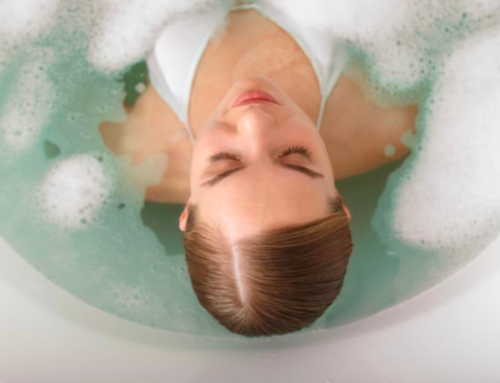If you’ve ever experienced a great session in a soaking tub, in your own bathroom, you already know the key to the experience. Simply put, it’s finding the right water temperature.
This is obvious when you nail the water temperature, but even more glaring when it goes wrong. No one wants a tepid tub when they’re looking for a long, hot soak, and many people are unaware that the materials from which the tub is made have a lot to do with that.
It’s a topic that’s well worth reviewing, so let’s take a look at some of the most common tub materials and see which ones do the best job with heat retention.
The Water Temp Factor: Choosing the Best Heated Bathtub Material to Retain Heat
As soon as you start searching for the best material to keep the water temperature warm in your bathtub, you’ll quickly notice a trend. Specifically, natural materials tend to do it best.
Warm Water Tub Types for Your Ideal Bathtub
Here are some of the ones that do the best job of retaining heat:
- Cast iron and enameled cast iron. While the heat retention capabilities of cast iron may be news to newer shoppers, fans of these tubs are well aware of its insulating properties.
The timeless, elegant period look of a cast iron bathtub is a huge part of the appeal, but don’t sleep on the heat retention with cast iron tubs. It’s superb, and a big part of the reason that these tubs have developed a devoted and almost cultish group of followers. - Stone and stone resin. Stone bathtubs can be a bit on the pricey side, but there are several good reasons that many buyers don’t mind paying extra to get them. Stone tubs basically scream “luxury bathing experience,” and when it comes to heat retention they’re commonly considered the next best option after cast iron tubs.
- Wood. Wood tubs are rare in today’s market, and they’re definitely harder to maintain. But they will keep you warm if you’re a fan and you don’t mind going the extra mile to find them.
- Acrylics. Some luxury tub buyers turn up their noses at acrylics, but if you’re on a tight budget they’re a great option.
They’re cheaper than cast iron, stone bathtubs and wood, plus they last a long time. They also do a solid job of resisting scratches, and you can even get them coated with materials that will help with heat retention.
What Are the Best Ways to Keep Water Warm in a Soaking Tub or a Freestanding Tub?
Choosing the right bathtub material is a great first step when it comes to keeping the water warm, but there are other things you can do to ensure a comfortable temperature experience as well.
Some tubs offer precision temperature selection to help you get exactly the level of heat you need, while many high-end tubs come with heaters and heating systems that allow you to maintain that initial perfect temperature that’s so comfortable and relaxing.
These heaters give you the level of control you need, which is important if you’re one of those people who likes an especially long soaking experience.
You can even get them with timers, but if you’re in the tub for the duration and you don’t want to be on the clock, you can either get a heating system without a timer or just mute the clock and ignore it completely.
Do Soaking Tubs Come with Heaters?
Companies that manufacture soaking tubs are well aware of how essential it is to maintain the perfect water temperature. As a result, the best ones make their tubs with a heating system, and some offer yet another option.
Surface heaters will actually warm the surface of the water, which is a somewhat different experience. It’s not for everyone, but many people who try it fall in love with it, so you should at least consider getting this kind of heating if it’s in your budget.
If you’re looking for the ultimate water heating option, you can even get a soaking tub with a heater that also uses jets. Jacuzzi is one of the companies that gives you this choice—they call heir tubs the Heated Soaking TUB COLLECTION, and it comes with two mini-jets that circulate warm water for as long as you’re in the tub to give you yet another variety on the relaxation experience.
Heated Soaking Tubs vs a Heated Bathtub
Now that you know a little bit about the heating options when it comes to heated soaking tubs, let’s compare them to heated bathtubs.
- Heated soaking tubs. One of the biggest advantages of a heated soaking tub is the depth of the tub, which can be 19 inches or more. The extra depth gives you a more immersive experience that covers your shoulders and neck, which is where many people hold tension and experience pain or discomfort.
The natural materials that these tubs are made of helps create a more luxurious experience as well. Whether your heated soaking tub is made of stone, wood or cast iron, the materials themselves will become part of the relaxation process. - Some people consider heated tubs more practical, and you can often get them with jets that create a massage experience. They also come with options like lights and sound systems, which enhances the overall bathing experience. They’re more traditional and less expensive, so if budget is an issue you may want to put them on your shopping list.
Shop for a Heated Bathtub at Hydro Massage Product Center and Get Perfect Water Temperature
At Hydro Massage, we’ve helped hundreds of customers choose the perfect bathtub for their needs. That includes soaking tubs, freestanding tubs and tubs with jets, and we can help you get the perfect water temperature if that’s a priority in your bathing experience.
To find out more, call us at (303) 356-7427, and you can also visit us at hydromassageproducts.com, where you can do a live chat to talk luxury and the specifics of how a deep soaking tub can help get you there. We also have some great videos and blog posts that will fill you in on the benefits of hydrotherapy and give you all the necessary information you need.
Also Read: Hydro Massage Products, America’s Best Jetted Tubs






